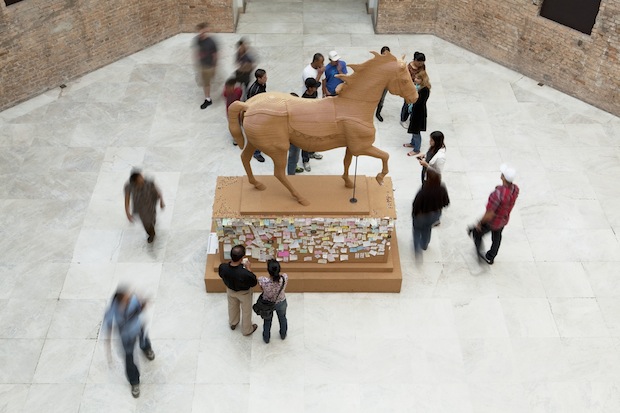
Paul Ramírez Jonas (Honduran-American, b. 1965). The Commons, 2011. Cork, pushpins, notes contributed by the public, 153 x 128 x 64 in. (388.6 x 135.1 x 162.6 cm). Courtesy of the artist and Koenig & Clinton Gallery. © Paul Ramírez Jonas. Photo: Paul Ramírez Jonas (Image courtesy of the Brooklyn Museum)
If you ran “post-gentrification Brooklyn” through an auto-art generator, we now know what the results would look like. They are on view at Crossing Brooklyn, the Brooklyn Museum’s attempt to create a significant borough-wide survey. Instead it has served up a cross-section of formulaic and utterly uninspiring works, all sourced locally, right here, in Brooklyn.
Spanning six rooms of video, photo-documentation, and sculpture typically evoking stuff you’d find on the street, the show opens into the fifth-floor atrium. Viewers are immediately confronted with Paul Ramírez Jonas’s “The Commons,” a thirteen-foot-tall replica of the horse in the ancient Roman statue “Equestrian Statue of Marcus Aurelius.” The original is in bronze and has an emperor on its back; this one is made of cork, and pushpins invite viewers to stick notes on it. It’s not a bad idea, but the results are less ambitious: you end up with a horse covered in Metro cards, Phish concert tickets, and IKEA receipts. (I came back two weeks after the press opening, and the additions were basically the same.)
Like so many of the works, the art-making formula begins something like being asked to make an artwork and answering “world peace.” A noble wish, one so simplistic that it basically walls off conversation before it can begin.
Let’s start with the concept of “diversity,” which is so often the fuzzy impetus for shows at this museum. It is treated not as the basic fabric of Brooklyn, but as “issues of diversity” which must be “dealt with,” i.e., a ton of “social-practice” works have the institutional seal written all over them. An example can be found in Puerto Rico-born Miguel Luciano’s “Amani Kites” which soars from the ceiling above Jonas’s horse.
Luciano worked with impoverished children from Nairobi. Through conversations he discovered that everyone he talked to shared the desire to fly; therefore, he made personalized kites displaying photos of the children. In a nearby video, Luciano reflects: “How you transform consciousness in any project is a really lofty goal.” He pauses, then adds “I don’t think it’s impossible.” (Flashback to Tim Rollins’s claims of “making history” with kids from the Bronx.)
The online film description explains that “the kites symbolize freedom to Mukuru residents and engender a dialogue transcending tribal and generational boundaries.” This includes extensive interviews of representatives from the Kuona Trust Center for Art talking about what they want the children to gain from the work (transcend colonialism) and Luciano explaining to children what the project is. We do not see, however, any creative input from the children. The expectation is that you prescribe an art assignment, and the public will automatically adopt your philosophy. Is there anything more colonialist than an artist going into a slum community and giving children a cultural project? This culminates in group kite flying, as Luciano speaks of “a notion of play or humor.”
The entire exercise is humorless, as kites are flown somberly on a hillside. They’re just kites.
It’s just one example of so, so many in which an artist gives a bunch of people an elementary school-level assignment and expects consciousness transformation to ensue. Other well-intended, but top-down efforts: a video of an “art walk” led by Elastic City, themed around inner beauty. For the past few years, Elastic City has been creating artist-led walks through public space with the aim to “make its audience active participants in an ongoing poetic exchange with the places we live in and visit.” It’s entirely unclear what “poetic exchange with the place with live in and visit” is. They’re doing weird stuff, which is supposed to be beneficial, but it’s never explained how.
In this particular piece, walk leader Todd Shalom instructs people to treat the crosswalk as a catwalk and write down their beauty secrets. Suddenly, Shalom stops his audience to take their “glamour shots” against a metal doorway. The instruction looks awkward. “BE GLAMOROUS!” people are notified. Feel the feeling, guys!

Nobutaka Aozaki (Japan, b. 1977). Smiley Bag Portrait, 2011. Participatory performance. Courtesy of the artist. ©Nobutaka Aozaki. Photo: Yuriko Katori (Image courtesy of the Brooklyn Museum)
Similarly, Nobutaka Aozaki has created a portrait station inspired by caricaturists in Times Square. Except Aozaki has replaced drawing paper with plastic smiley face bags—onto which the artist Sharpies hair, glasses, etc. The result: a bunch of photos of visitors holding up their bags vaguely in their likeness and smiling. Let’s assume that something personal is captured by rendering a ubiquitous symbol with the hairdo you were wearing that day, and that free giveaways automatically make social “engagement.” It’s equally likely that the reasons for doing so are to position the project as art. Frankly, that’s not a wholly altruistic motive.
Other times the show just looks like a “Taxi TV” ad for Brooklyn Culture. “Pimp my Paragua,” (in English, “Pimp My Snow Cone”) also by Miguel Luciano, comes with footage of Luciano shaving ice and delivering cones to unsuspecting bystanders from a freshly painted 1960s-style paragua cart with Jíbaro music. There’s precious little else than to surprise people with free giveaways and share a piece of culture. What sets this apart from a paragua cart or a Brooklyn taco stand? The food is free, and it’s distributed by an artist.
Most indicative of the show’s limited social perspective can be found in McKendree Key’s “176 Clifton Place to Lafayette Gardens,” in which a video camera jerkily runs on a pulley system through a series of Brooklyn apartments; through a space under renovation, to a condo, over the yard, and across the street. Neighbors help guide the camera at checkpoints like trees and windows, and after what feels like an interminably long couple of minutes of trying to successfully move the lens across the yard to the next building, the video abruptly stops at the doorstep of the Lafayette Gardens NYCHA building. There’s no assistant to help guide the camera through this window, which is where the poor people live. Why? One is left with the impression that nobody went over there. In an artwork which attempts to show gentrification in Brooklyn, this is a problem.
Other publicly aimed works take a one-dimensional representational approach, transforming familiar Brooklyn landmarks from a non-commuter angle. Duke Riley’s pigeon-cams offer a jerky, pigeon-eye view of rooftops. Marie Lorenz videotapes views of the city from a boat. Drew Hamilton has built a perfect 9-foot-tall mini-version of the bodega across the street from his apartment. That’s it. The greatest surprise to come from this work is astonishment that such depthless depictions of our borough have made it into the museum.
And what’s up with all the vague poeticism and generic renderings of the sublime? The enormous projections of kaleidoscopic clouds by Kambui Olujimi are vaguely intended to make people think of love. Cynthia Daignault has made a room full of cloud paintings, all blue and white, as an exercise in describing form with a range of wispy strokes. William Lamson has made a video in which he appears to be walking on the Delaware River, though repeatedly struggling with his underwater floatation devices. “There’s just something about it that’s so beautiful, but it’s impossible to say why,” one visitor remarked. I, for one, could not stop thinking about the plastic bag from American Beauty: a Hollywood copy of what a transcendent moment looks like.

Nina Katchadourian, an image from “Lavatory Self Portraits in The Flemish Style” (Image from http://www.ninakatchadourian.com)
There were few precious nuggets in the blandness, and only one truly stood out: Nina Katchadourian’s Seat Assignment series, a series of photographs and videos all taken on airplanes. This includes “In a Room Full of Strangers (2011) from “Seat Assignment” (2010 and ongoing)” three-screen self -portrait videos shot on what look likes an iPhone video; in them, the artist has fashioned colonial garb from napkins, toilet paper, and hand towels. Katchadourian’s three selves harmonize with each other lip synching the Bee Gees’ “Nights on Broadway.” Contrasting the silly song and toilet paper hats, her expression of utter seriousness and pain makes it impossible to look away. For Katchadourian, the world of garbage and detritus is a playground to be made from, not one to impose a prefab art idea upon. Having visited the show twice, I can safely say it’s the only example of an artist using true creative license. It’s a skill you don’t acquire with an art degree, you can’t replicate, and you can’t professionalize, though many are obviously trying.


{ 5 comments }
From what asshole did you crawl out of. You clearly have a bone to pick with people in this exhibit or you’ve just revealed yourself to be the pre-madonna dick from freshman poetry class. We already read this in The New York Times, so what does your nastiness provide? Ok yr witty. got it. Write something that makes me want to go see something worthwhile instead of wasting your/my time writing about things you love to hate.
Srsly, new self aggrandizing low there for AFC. You can do better. Grl, go back to pitchfork and don’t come back until yr alls adults n’ all.
IRREGARDLESS the Times trashed it WHY pile on!? Vicious and depraved, you can do better. Try again. In fact, get someone to write a glowing review for a show the BM gave basically zero financial resources for bc FRIENDS.
I see we have a bunch of commenters who are either artists in the show or have friends in the show and feel slighted. Both commenters are being blocked. Why? Because these comments exist only to express rage – not to talk about the art.
Let’s just lie.
I knew I should have put more animated gifs in my piece! Dammit.
Comments on this entry are closed.